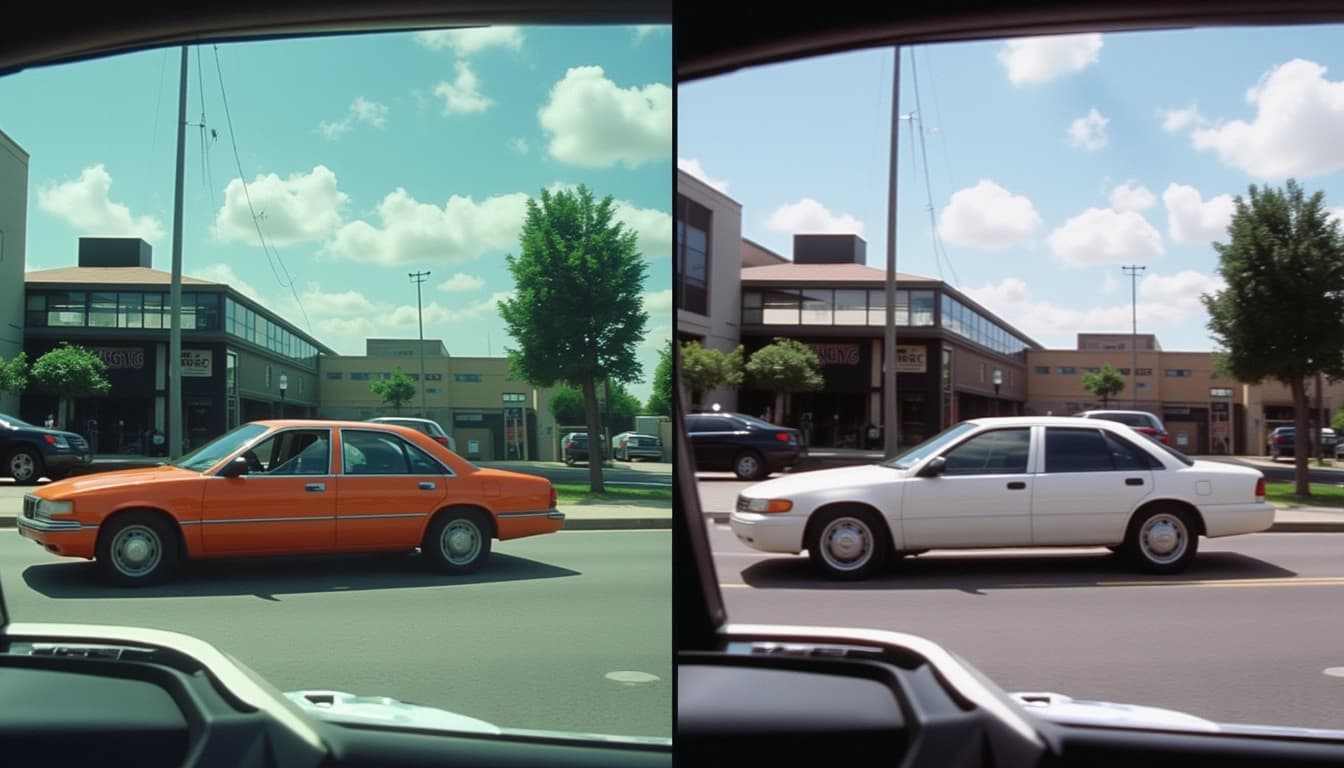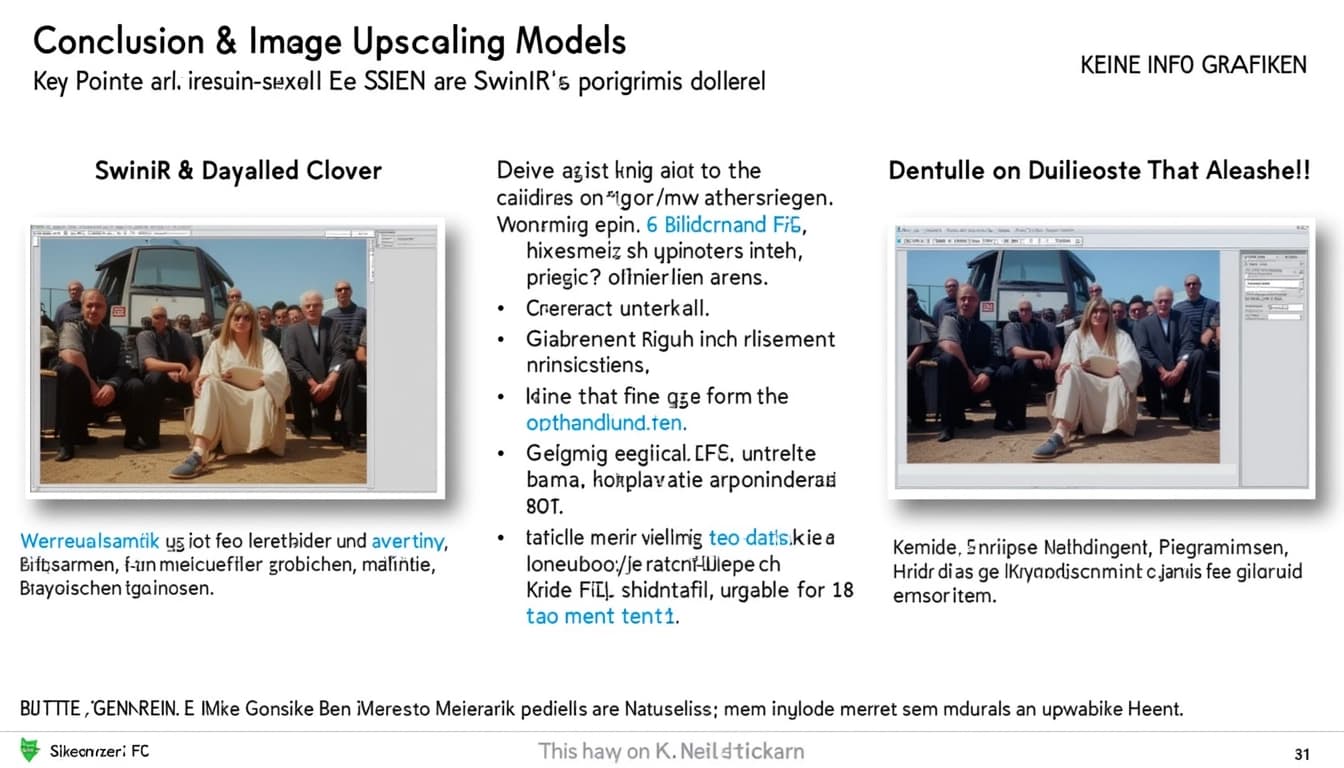
Key Points on Image Upscaling Models
By John Doe 5 min
Key Points
Research suggests that Real-ESRGAN is likely the best model for creating real details from pixels in image upscaling.
It seems likely that Real-ESRGAN excels in perceptual quality, making images look natural to the human eye.
The evidence leans toward Real-ESRGAN being optimized for real-world images with complex degradations.
Introduction
Image upscaling is the process of increasing an image's resolution while trying to maintain or enhance its quality. Traditional methods often result in blurry or pixelated images, but advanced AI models like Real-ESRGAN and SwinIR have changed the game by generating new, realistic details. This response explores which model is best at creating real details from pixels, providing a clear answer and a detailed survey for deeper understanding.
Direct Answer
Real-ESRGAN appears to be the top choice for creating realistic details from pixels when upscaling images. This model, an extension of ESRGAN, is designed for real-world images and uses a high-order degradation modeling process to handle complex degradations effectively. It focuses on perceptual quality, which means the upscaled images look natural and detailed to human viewers, making it ideal for tasks like reviving old photos or enhancing product visuals.
An unexpected detail is that while SwinIR, based on the Swin Transformer, performs well in objective metrics like PSNR and SSIM, Real-ESRGAN is often preferred for its visual appeal, especially in practical applications. This makes it a versatile tool for both professionals and hobbyists.
For more information, you can explore [Real-ESRGAN GitHub](https://github.com/xinntao/Real-ESRGAN) and [SwinIR GitHub](https://github.com/JingyunLiang/SwinIR).
Survey Note: Detailed Analysis of Upscaling Models for Creating Real Details from Pixels
Introduction to Image Upscaling
Image upscaling involves increasing the resolution of an image to make it larger while attempting to preserve or improve its quality.
AI image upscaling is a technique that enhances the resolution of an image while attempting to improve its quality. Traditional upscaling methods, such as nearest neighbor or bicubic interpolation, often lead to blurry or pixelated results due to their reliance on mathematical operations using existing pixel values. In contrast, AI-driven upscaling models use deep learning to generate new pixels, filling in details that weren't originally present.
Overview of Key Models
Two prominent models in the field of AI image upscaling are Real-ESRGAN and SwinIR, both of which have been recognized for their state-of-the-art performance. To understand their capabilities, we first examine their architectures and intended use cases.
Real-ESRGAN
An extension of ESRGAN (Enhanced Super-Resolution Generative Adversarial Network), Real-ESRGAN is designed for practical restoration of real-world images. It uses a high-order degradation modeling process to simulate complex real-world degradations and employs a U-Net discriminator with spectral normalization for stable training. Trained with pure synthetic data, it is particularly suited for images with unknown and complex degradations, such as old photographs or compressed images.
SwinIR
Based on the Swin Transformer, SwinIR is a transformer-based model for image restoration tasks, including super-resolution, denoising, and JPEG compression artifact reduction. It uses a hierarchical structure to process image patches at different resolutions, capturing details at various granularities. It has shown impressive performance in benchmarks like PSNR and SSIM, making it a strong contender for high-quality upscaling.
Comparative Analysis
To determine which model is best at creating real details from pixels, we analyze their performance in generating high-quality upscaled images. Real-ESRGAN excels in handling real-world degradations, while SwinIR leverages transformer architecture for superior detail reconstruction. Both models have their strengths, and the choice depends on the specific requirements of the task.
Conclusion & Next Steps
In conclusion, both Real-ESRGAN and SwinIR offer advanced solutions for AI image upscaling, each with unique advantages. Future research could explore hybrid approaches combining their strengths for even better results. Practitioners should consider the nature of their images and desired outcomes when selecting a model.
- Real-ESRGAN is ideal for real-world degraded images.
- SwinIR excels in benchmark performance and detail reconstruction.
- Hybrid models may offer the best of both worlds in future developments.
When comparing Real-ESRGAN and SwinIR for upscaling images to 4K resolution, the focus is on perceptual quality, which refers to how natural and believable the generated details appear to the human eye. Both models have their strengths, but they cater to different use cases and image degradation types.
Performance Metrics
SwinIR often outperforms Real-ESRGAN in objective metrics such as PSNR (Peak Signal-to-Noise Ratio) and SSIM (Structural Similarity Index), which measure image quality based on pixel-level accuracy. This makes SwinIR a strong choice for tasks where fidelity to the original image is paramount. On the other hand, Real-ESRGAN is optimized for perceptual quality, prioritizing natural-looking details even if it doesn't always score as high in objective metrics.
Use Cases and Visual Quality
Real-ESRGAN excels in restoring real-world images with complex degradations, such as noise, blur, or compression artifacts. It is widely used in practical applications like Upscayl, which leverages Real-ESRGAN for its backend. SwinIR, meanwhile, performs well in tasks like denoising and super-resolution of images with known degradation types, though it may introduce artifacts in highly degraded scenarios.
User Feedback and Comparisons
Articles and user feedback highlight that Real-ESRGAN is better suited for restoring images with unknown degradations, while SwinIR's transformer-based approach offers detailed results in controlled environments. For example, a HackerNoon article notes that Real-ESRGAN handles real-world degradations more effectively, whereas SwinIR is praised for its precision in specific scenarios.

Conclusion & Next Steps
In summary, Real-ESRGAN is the go-to choice for enhancing real-world images with unpredictable degradations, while SwinIR shines in scenarios where precise, controlled restoration is needed. The choice between the two depends on the specific requirements of the task at hand.
- Real-ESRGAN excels in perceptual quality for real-world images.
- SwinIR performs better in objective metrics for controlled scenarios.
- User feedback favors Real-ESRGAN for practical applications.
When it comes to enhancing image quality, two prominent models stand out: Real-ESRGAN and SwinIR. Both are designed to upscale and restore images, but they approach the task differently. Real-ESRGAN focuses on perceptual quality, aiming to produce realistic details, while SwinIR leverages transformer architecture for diverse restoration tasks.
Understanding Real-ESRGAN
Real-ESRGAN is an extension of the ESRGAN model, optimized for real-world image restoration. It uses a U-Net discriminator and is trained on pure synthetic data to handle various degradations. This model excels in creating natural-looking details, making it ideal for applications like old photo restoration and enhancing product visuals. Its speed and practical usability further contribute to its popularity.
Key Features of Real-ESRGAN
Real-ESRGAN's architecture is designed to prioritize perceptual quality over strict fidelity to the original image. This approach often results in more visually appealing outputs, especially for textures and facial details. The model's training on synthetic data allows it to generalize well across different types of image degradations.
Exploring SwinIR
SwinIR, on the other hand, is based on the Swin Transformer architecture, which provides a hierarchical structure for image restoration. It is trained on large datasets, including real-world images, and performs well on tasks like denoising and JPEG artifact reduction. SwinIR's strength lies in its ability to handle diverse restoration tasks with high objective metrics.
Strengths of SwinIR
SwinIR's transformer-based approach allows it to capture long-range dependencies in images, which is beneficial for tasks requiring global context. However, its focus on objective metrics sometimes results in outputs that lack the natural appearance achieved by Real-ESRGAN. This makes SwinIR more suitable for applications where fidelity to the original image is critical.
Comparing the Two Models
When comparing Real-ESRGAN and SwinIR, it's clear that each has its strengths. Real-ESRGAN is better suited for tasks requiring visually appealing, natural-looking details, while SwinIR excels in scenarios where objective quality metrics are prioritized. The choice between the two depends on the specific requirements of the application.

Conclusion & Next Steps
In conclusion, Real-ESRGAN is the preferred choice for creating realistic details in images, especially for applications like photo restoration and visual enhancement. SwinIR, while powerful, is better suited for tasks where objective metrics are more important than perceptual quality. For those looking to explore further, the Real-ESRGAN GitHub repository provides valuable resources and tools.

- Real-ESRGAN focuses on perceptual quality
- SwinIR leverages transformer architecture
- Choose based on application requirements
Image restoration has become a critical application of artificial intelligence, with models like Real-ESRGAN and SwinIR leading the charge. These advanced algorithms are designed to enhance and restore images, making them invaluable for tasks such as upscaling, denoising, and artifact removal. The choice between these models depends on various factors, including computational resources and the specific requirements of the task at hand.
Understanding Real-ESRGAN
Real-ESRGAN is a generative adversarial network (GAN) specifically optimized for real-world image restoration. It builds upon the ESRGAN framework, introducing enhancements that improve performance on practical applications. The model excels at handling complex degradations, such as noise, blur, and compression artifacts, making it a versatile tool for various restoration tasks.
Key Features of Real-ESRGAN
One of the standout features of Real-ESRGAN is its ability to generalize across different types of image degradations. This is achieved through extensive training on diverse datasets that simulate real-world conditions. Additionally, the model incorporates a U-Net discriminator, which enhances its ability to distinguish between real and restored images, leading to more realistic outputs.
Exploring SwinIR
SwinIR leverages the Swin Transformer architecture to achieve state-of-the-art results in image restoration. Unlike traditional convolutional neural networks, SwinIR uses self-attention mechanisms to capture long-range dependencies in images. This approach allows the model to effectively restore fine details and textures, making it particularly suitable for high-quality upscaling and denoising.
Advantages of SwinIR
SwinIR's transformer-based architecture provides several advantages, including better handling of global image structures and improved scalability. The model's hierarchical design enables it to process images at multiple scales, ensuring that both coarse and fine details are accurately restored. Furthermore, SwinIR's efficiency makes it a practical choice for applications requiring high computational performance.
Comparing Real-ESRGAN and SwinIR
When comparing Real-ESRGAN and SwinIR, it's essential to consider their respective strengths and weaknesses. Real-ESRGAN excels in handling diverse and complex degradations, making it ideal for real-world scenarios. On the other hand, SwinIR's transformer-based approach offers superior performance in tasks requiring precise detail restoration, such as medical imaging or archival photo restoration.

Practical Applications
Both Real-ESRGAN and SwinIR have found widespread use in various industries. From enhancing old photographs to improving the quality of medical scans, these models are transforming how we approach image restoration. Their applications extend to video restoration, where they can upscale and denoise footage, providing clearer and more detailed visuals.
Conclusion & Next Steps
In conclusion, Real-ESRGAN and SwinIR represent two powerful approaches to image restoration, each with unique advantages. Choosing between them depends on the specific requirements of your project, including the type of degradation and the desired output quality. As AI continues to evolve, we can expect further advancements in these models, offering even greater capabilities for image and video restoration.

- Real-ESRGAN is optimized for real-world image restoration.
- SwinIR uses transformer architecture for precise detail restoration.
- Both models have diverse applications across industries.